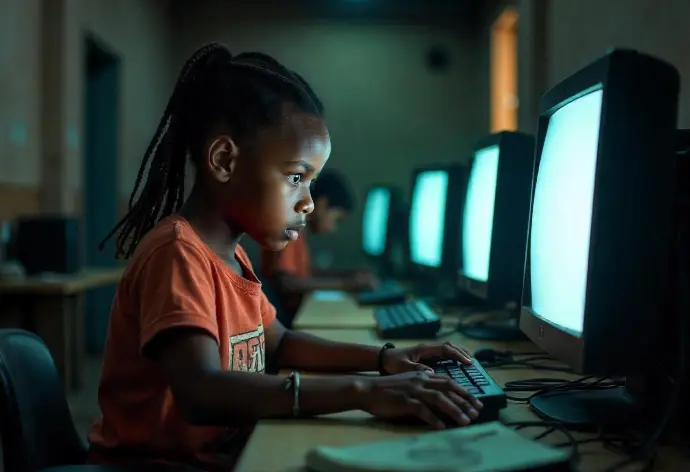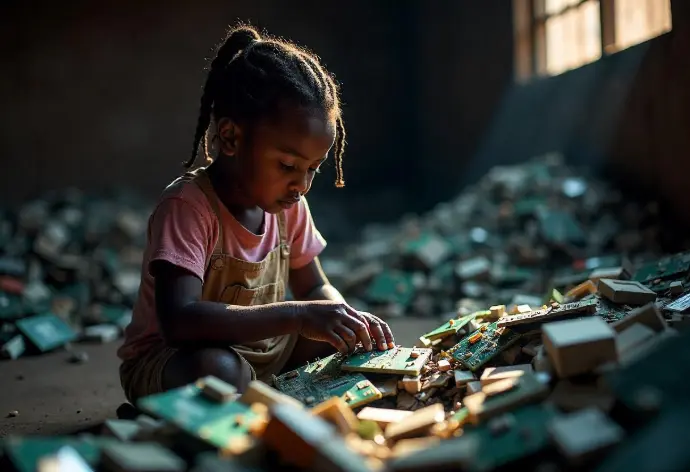Introduction
Child labor in the digital age currently represents a significant challenge for global society. Digital interconnectedness has brought with it new forms of labor exploitation that affect children around the world. This phenomenon poses unique challenges for the protection of human rights, particularly in the workplace. It is crucial to examine in detail the context, impact, and current challenges related to child labor in the digital age.
The digital age has transformed the nature of work, providing new opportunities but also significant challenges. In this context, child labor has found new ways to manifest itself, whether through children's participation in the production of digital goods, performing tasks on online platforms, or participating in the digital economy in ways that jeopardize their well-being and development.
Accessibility to digital devices and internet connectivity has expanded job opportunities, but has also increased children's exposure to exploitative labor situations. The lack of effective regulations and the difficulty of enforcing labor laws in digital environments have contributed to the persistence of child labor in this new context.
Understanding the changing dynamics of child labor in the digital age is essential to developing effective strategies to protect children's rights in this environment.
Child labor in the digital age not only affects the well-being of the children involved but also has significant repercussions for contemporary society. The exploitation of child labor contributes to perpetuating cycles of poverty, limits access to education, and undermines the comprehensive development of new generations.
Furthermore, child labor in the digital age poses ethical and moral challenges, as the participation of children in labor activities not only violates their fundamental rights but also has implications for how work and equity are conceived in the digital age. Addressing this problem is crucial to promoting more just and equitable societies.
The impact of child labor in contemporary society requires a comprehensive response that addresses not only the immediate consequences for children but also the long-term implications for sustainable development and social justice.
The fight against child labor in the digital age faces complex challenges arising from the very nature of the digital economy. The lack of clear borders, the difficulty in tracking and regulating online work activities, and the rapid evolution of digital platforms represent significant obstacles to the eradication of child labor.
Furthermore, the need to reconcile the protection of children's rights with the promotion of innovation and technological development raises ethical and political dilemmas. It is crucial to find a balance that fosters digital progress without compromising the safety and well-being of children.
Current challenges in the fight against child labor require international collaboration, the implementation of effective regulatory frameworks, and the development of strategies that recognize the specificities of the digital economy. Only through a comprehensive approach will it be possible to protect children from labor exploitation in the digital age.
Child Labor in the Digital Age
Child labor in the digital age refers to the participation of children and adolescents in labor activities in the context of technology and the internet. These activities may include the production of digital goods, performing tasks on online platforms, participating in the gig economy, among other forms of work carried out through digital means.
This type of child labor can manifest itself in various forms, such as participation in the production of digital content, performing tasks through freelancing platforms, exposure to dangerous online work, or the misuse of minors' image and identity in digital work environments.
It is important to note that child labor in the digital age can present unique challenges compared to traditional child labor, due to the changing and dynamic nature of the digital environment.
According to the International Labor Organization (ILO), an estimated 152 million children worldwide are engaged in child labor, a significant proportion of whom are involved in activities related to the digital age.
Recent trends show an increase in the participation of children and adolescents in online work, especially in areas such as producing content for social media, performing microtasks, and participating in online gaming platforms that involve economic transactions.
In addition, there has been an increase in children's exposure to risky situations online, including exploitation through digital media and participation in activities that affect their physical and emotional well-being.
Child labor in the digital age can have significant effects on children's physical and psychological development. Prolonged exposure to screens and digital devices can contribute to health problems such as eye strain, sleep disorders, and sedentary lifestyles.
Furthermore, the pressure to meet work demands in digital environments can affect children's mental health, generating stress, anxiety, and difficulties managing interpersonal relationships and work-life balance.
It is essential to understand and address the impact of child labor in the digital age, considering both the physical and psychological implications that can arise from this form of labor participation in the digital context.
The relationship between poverty and child labor in the digital age is a highly relevant issue today. Poverty is a determining factor that drives many families to resort to child labor as a means of subsistence. In the digital age, this situation is exacerbated by the ease with which children can be exploited through online platforms, where they can perform tasks such as collecting recyclable materials, completing surveys, or participating in the creation of digital content.
The lack of access to quality education and job opportunities for adults living in poverty means that children are forced to contribute to family income from an early age. In many cases, child labor in the digital age takes place in precarious conditions and without the necessary protections, which puts both the physical and emotional well-being of children at risk.
It is essential to address the relationship between poverty and child labor in the digital age from a comprehensive perspective, including measures to combat poverty, guarantee access to education, and create decent job opportunities for adults. Likewise, effective regulations and oversight mechanisms must be established to prevent and eradicate the labor exploitation of children in digital environments, thus protecting their fundamental rights.
Labor Rights in the Digital Age
International child labor law has been a crucial issue in the fight to protect children from labor exploitation. The International Labor Organization (ILO) establishes standards for the protection of children's rights in the workplace through the Minimum Age Convention and the Worst Forms of Child Labor Convention. These legal instruments seek to ensure that children can enjoy a childhood free from labor exploitation, with access to education and safe and healthy conditions.
In the context of the digital age, it is essential that countries ratify and comply with these international regulations, adapting them to the new labor reality presented by digital platforms. The protection of children's rights in the digital environment is a challenge that requires international cooperation and updated legal frameworks that effectively address this issue.
It is important that governments strengthen their policies and legislation to prevent and eradicate child labor in the digital age, ensuring that platforms and companies comply with current regulations and protect the rights of minors who may be involved in their operations.
The regulation of child labor on digital platforms presents specific challenges derived from the very nature of these platforms. The lack of direct supervision, the difficulty in verifying the age of workers, and the globalization of these platforms make the regulation and prevention of child labor more complex.
Furthermore, the rapid evolution of technologies and the constant creation of new platforms and applications require legislation to remain up-to-date and capable of adapting to these changes. It is essential that regulatory frameworks take into account the dynamics and versatility of the digital economy in order to effectively protect children from labor exploitation in this environment.
Collaboration between governments, international organizations, businesses, and civil society is essential to address these challenges and establish oversight and monitoring mechanisms that guarantee respect for children's rights in the digital workplace.
Given the complexity of child labor in the digital age, various initiatives and programs have emerged to combat this problem. The ILO, for example, has developed the International Programme on the Elimination of Child Labor (IPEC+), which seeks to promote comprehensive and sustainable policies to eliminate the worst forms of child labor, including those occurring in the digital context.
Likewise, civil society organizations, businesses, and government entities have established alliances and training, awareness-raising, and reporting programs to prevent and combat child labor on digital platforms. These initiatives seek to raise public awareness, train workers, and establish reporting and monitoring channels to identify and respond to potential cases of child exploitation in the digital sphere.
It is essential that these programs be strengthened and expanded, promoting collaboration between different actors to protect children from labor exploitation in the digital age and guarantee them a safe, healthy, and conducive environment for their comprehensive development.
Companies, especially those operating in the digital age, have a fundamental responsibility in preventing child labor. It is crucial that they take a proactive role in identifying and eradicating all forms of child labor exploitation in their supply chains and operations. This involves implementing strong policies that prohibit child labor and ensure that their suppliers and business partners adhere to the same standards.
In addition, companies must conduct thorough due diligence to assess and address child labor risks in their operations. This includes conducting regular audits, collaborating with labor rights organizations, and training their staff to identify potential cases of child labor. It is also essential that companies establish confidential and accessible reporting channels so that workers and other stakeholders can report any suspicion of child labor without fear of retaliation.
Additionally, companies can use their influence and resources to support programs and projects aimed at eradicating child labor in the communities where they operate. This can include investing in education, supporting sustainable economic development initiatives, and promoting fair and safe labor practices for adults, which in turn helps reduce families' vulnerability to economic child labor.
Impact on the Global Economy
Child labor in the digital age has a series of economic and social consequences that affect both the local and global levels. Economically, child labor can contribute to lower wages for adult workers, as children and adolescents often accept lower wages and precarious working conditions. This can lead to unfair competition in the labor market, affecting the economic stability of families and communities.
Socially, child labor in the digital age deprives children and adolescents of the opportunity to receive an adequate education, perpetuating the cycle of poverty and limiting their opportunities for personal and professional development. Furthermore, it can expose children to situations of exploitation and abuse, compromising their emotional and physical well-being.
These consequences have a significant impact on the global economy, as the lack of education and equal opportunities limits the growth potential of future generations, affecting the workforce and the long-term competitiveness of countries.
Child labor in the digital age is closely linked to unfair competition in the labor market. The availability of cheap and unregulated child labor can lead to the exploitation of these children and lower labor standards for adult workers. Companies that profit from child labor can offer products and services at lower prices, giving them an unfair competitive advantage in the marketplace.
This situation not only affects adult workers, whose jobs and working conditions are threatened, but also perpetuates a cycle of poverty and inequality by depriving children of the opportunity for adequate education and development. Unfair competition stemming from child labor in the digital age undermines efforts to promote a fair and equitable economy globally.
Addressing this relationship is crucial to ensuring fair working conditions and protecting children's rights, while promoting fair and sustainable competition in the digital labor market.
Eradicating child labor in the digital economy requires a comprehensive approach involving governments, businesses, international organizations, and society as a whole. It is essential to implement and enforce laws and regulations that prohibit child labor and guarantee fair working conditions for all. Companies must also assume responsibility for monitoring their supply chains and ensuring that child labor is not used in the production of goods and services.
Furthermore, it is necessary to invest in education and development programs that provide children and adolescents with real opportunities for growth and empowerment, removing them from the need to work at an early age. Collaboration between the public and private sectors, along with civil society, is essential to creating sustainable solutions that address the root causes of child labor in the digital age.
By promoting measures that foster equal opportunities and protect children's rights, we can move toward a more just and ethical digital economy, where child labor is eradicated and replaced with safe and equitable work environments for all ages.
Conclusions
In the digital age, child labor presents new challenges that require specific attention. Technology has opened up new forms of exploitation, such as child labor in the production of electronic products, participation in digital production chains, and exposure to harmful online content. These challenges require thorough exploration and in-depth analysis to understand the magnitude of the problem and develop effective strategies to address it.
Furthermore, the global nature of the digital economy makes it difficult to effectively monitor and regulate child labor. Children may be involved in labor activities across international borders, complicating the identification and protection of the minors involved. Therefore, it is crucial to develop transnational and collaborative approaches to address child labor in the digital age.
Finally, the rapid evolution of technology poses the additional challenge of anticipating and mitigating emerging risks associated with child labor in digital environments. This requires constant vigilance and the swift adaptation of strategies and regulations to protect children from online exploitation.
The eradication of child labor in the digital age is a challenge that transcends national borders and requires a globally coordinated response. International collaboration is essential to address the complexities of child labor in a globalized digital environment. This involves harmonizing laws and regulations, sharing best practices, and cooperating in implementing prevention and protection strategies.
Furthermore, public awareness plays a critical role in combating child labor in the digital age. Informing society about the implications of child labor in the digital economy can drive changes in consumer behavior and generate pressure on companies to adopt responsible practices. Awareness raising can also mobilize support for programs and policies aimed at protecting children from online exploitation.
International collaboration and public awareness are fundamental pillars in the fight against child labor in the digital age. These elements are key to developing a comprehensive approach that addresses both current and future challenges in protecting children's rights in the digital economy.

 IHRO NEWS
IHRO NEWS





